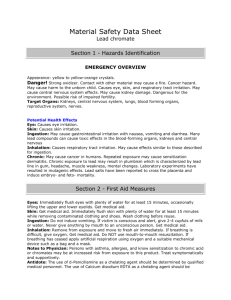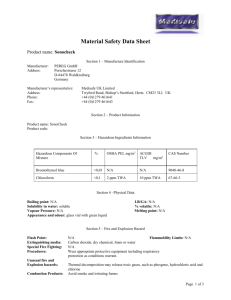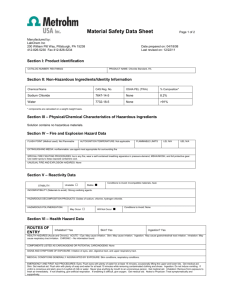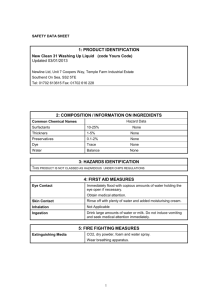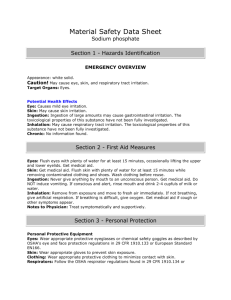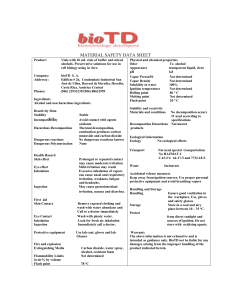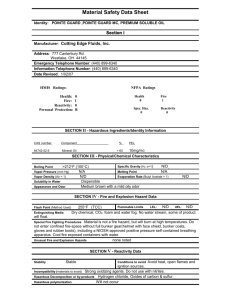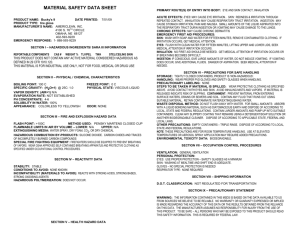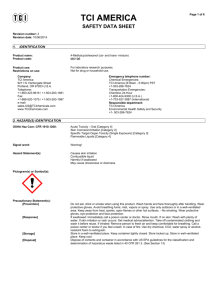SNO-FLO - Rhomar Industries
advertisement
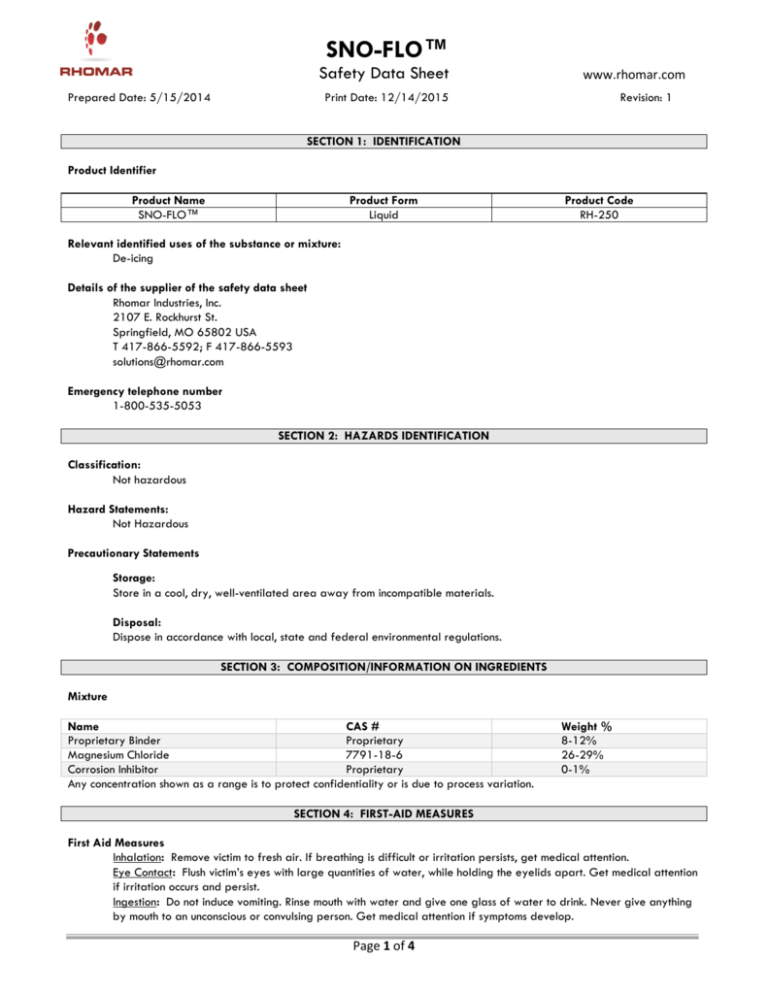
SNO-FLO™ Safety Data Sheet Prepared Date: 5/15/2014 www.rhomar.com Print Date: 12/14/2015 Revision: 1 SECTION 1: IDENTIFICATION Product Identifier Product Name SNO-FLO™ Product Form Liquid Product Code RH-250 Relevant identified uses of the substance or mixture: De-icing Details of the supplier of the safety data sheet Rhomar Industries, Inc. 2107 E. Rockhurst St. Springfield, MO 65802 USA T 417-866-5592; F 417-866-5593 solutions@rhomar.com Emergency telephone number 1-800-535-5053 SECTION 2: HAZARDS IDENTIFICATION Classification: Not hazardous Hazard Statements: Not Hazardous Precautionary Statements Storage: Store in a cool, dry, well-ventilated area away from incompatible materials. Disposal: Dispose in accordance with local, state and federal environmental regulations. SECTION 3: COMPOSITION/INFORMATION ON INGREDIENTS Mixture Name CAS # Proprietary Binder Proprietary Magnesium Chloride 7791-18-6 Corrosion Inhibitor Proprietary Any concentration shown as a range is to protect confidentiality or is due to process variation. Weight % 8-12% 26-29% 0-1% SECTION 4: FIRST-AID MEASURES First Aid Measures Inhalation: Remove victim to fresh air. If breathing is difficult or irritation persists, get medical attention. Eye Contact: Flush victim’s eyes with large quantities of water, while holding the eyelids apart. Get medical attention if irritation occurs and persist. Ingestion: Do not induce vomiting. Rinse mouth with water and give one glass of water to drink. Never give anything by mouth to an unconscious or convulsing person. Get medical attention if symptoms develop. Page 1 of 4 SNO-FLO™ Prepared Date: 5/15/2014 Skin Contact: Wash skin thoroughly with soap and water. Get medical attention if irritation develops. Remove and launder clothing before use. Most Important Symptoms and Effects, both Acute and Delayed Symptoms May cause slight eye and skin irritation. Indication of any Immediate Medical Attention and Special Treatment Needed Immediate medical attention is not required. SECTION 5: FIRE-FIGHTING MEASURES Suitable Extinguishing Media Use media appropriate for surrounding fire. Cool fire exposed containers and structures with water. Unsuitable Extinguishing Media Not determined. Specific Hazards Arising from the Chemical Thermal decomposition may yield oxides of carbon and other harmful or irritating chemicals. Protective Equipment and Precautions for Firefighters Firefighters should wear positive pressure self-contained breathing apparatus and full protective clothing. Aqueous solutions may cause surfaces to be extremely slippery and cause a slip hazard. SECTION 6: ACCIDENTAL RELEASE MEASURES Personal Precautions, Protective Equipment and Emergency Procedures Personal Precautions Wear appropriate protective clothing as described in Section 8. Wash thoroughly after handling. Methods and Material for Containment and Cleaning Up Dike and collect liquid or absorb with an inert absorbent and place in appropriate containers for disposal. Flush spill area with water. Report releases as required by local, state, and federal authorities. SECTION 7: HANDLING AND STORAGE Precautions for Safe Handling Advice on Safe Handling Avoid contact with the eyes, skin, and clothing. Avoid breathing mists. Wear protective clothing and equipment as described in Section 8. Wash thoroughly with soap and water after handling. Keep containers closed when not in use. Conditions for Safe Storage, Including any Incompatibilities Storage Conditions Store in cool, dry, well-ventilated area away from incompatible materials. Product may be corrosive to some metals. SECTON 8: EXPOSURE CONTROLS/PERSONAL PROTECTION Exposure Guidelines Chemical Name Guidelines Proprietary Binding Agent None Established Magnesium Chloride None Established Proprietary Additive None Established Appropriate Engineering Controls Engineering Controls: Use with adequate general ventilation to minimize exposures. Page 2 of 4 SNO-FLO™ Prepared Date: 5/15/2014 Individual Protection Measures, such as Personal Protective Equipment Eye/Face Protection: Safety glasses recommended. Skin and Body Protection: Wear impervious gloves such as rubber or neoprene if needed to avoid prolonged skin contact. Respiratory Protection: In operations where exposure levels are excessive, a NIOSH approved respirator with dust/mist cartridges or supplies air respirator appropriate for the form and concentration of the contaminants should be used. Selection and use of respiratory equipment must be in accordance with OSHA 1910.134 and good industrial hygiene practice. Other: Long-sleeved clothing and long pants recommended to avoid prolonged skin contact. Suitable washing facilities should be available in the work area. SECTION 9: PHYSICAL AND CHEMICAL PROPERTIES Information on Basic Physical and Chemical Properties Physical State Color Liquid Translucent Green pH Boiling Point/Boiling Range Evaporation Rate Upper Flammable Limits Vapor Pressure Relative Density VOC Content Decomposition Temperature Solubility Odor Threshold 6.5 – 7.5 212°F Not determined Not determined Not determined 1.25-1.32 Not determined Not determined Complete Not established Freezing Point Flash Point Flammability (Solid, Gas) Lower Flammable Limits Vapor Density Water Solubility Autoignition Temperature Octanol/Water Coefficient Viscosity Odor -28°F Not determined Not applicable Not determined Not determined Soluble Not determined Not determined <300 cP @ 20°C Little odor SECTION 10: STABILITY AND REACTIVITY Reactivity Not normally reactive. Chemical Stability Stable under normal storage and handling conditions. Possibility of Hazardous Reactions None known. Conditions to Avoid None known. Incompatible Materials Strong oxidizing agents, concentrated acids, and some metals. Hazardous Decomposition Products When heated to decomposition emits oxides of carbon and other harmful or irritation chemicals. SECTION 11: TOXICOLOGICAL INFORMATION Health Hazards: Inhalation: Inhalation of mists may cause slight irritation of the nose, throat, and upper respiratory tract. Eye Contact: May cause mild to moderate irritation with pain and tearing. Skin Contact: May cause slight irritation on prolonged or repeated contact. Ingestion: Ingestion may cause slight irritation with nausea, vomiting, and diarrhea. Sensitization: This material is not known to cause sensitization. Page 3 of 4 SNO-FLO™ Prepared Date: 5/15/2014 Chronic: None known. Carcinogenicity: None of the components is listed as a carcinogen or suspected carcinogen by IARC, NTP, or OSHA. Germ Cell Mutagenicity: None currently known. Reproductive Toxicity: None currently known. Numerical Measures of Toxicity: No toxicity data available. SECTION 16: OTHER INFORMATION NFPA Ratings: Health: Flammability: Instability: 0 0 0 HMIS Ratings: Health: 1 Flammability: 0 Physical Hazard: 0 Indication of changes: Revision-1 Date Sheet Prepared: 5/15/2014 The information herein is presented in good faith and believed to be correct as of the date hereof. However, the manufacturer makes no representation as to the completeness and accuracy thereof. Users must make their own determination as to the suitability of the product for their purposes prior to use. No representations or warranty’s, either express or implied of merchantability, fitness for a particular purpose or of any other nature with respect to the product or to the information herein is made hereunder. The manufacturer shall in no event be responsible for any damages of whatsoever nature directly or indirectly resulting from the publication or use of or reliance upon information contained herein. Page 4 of 4
